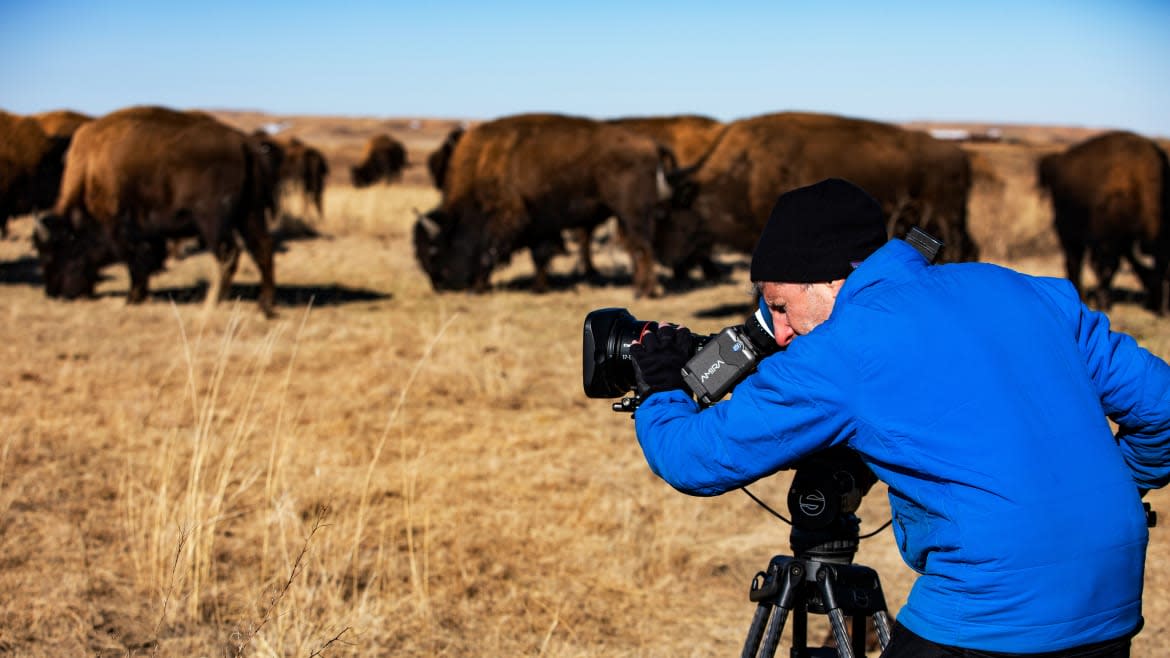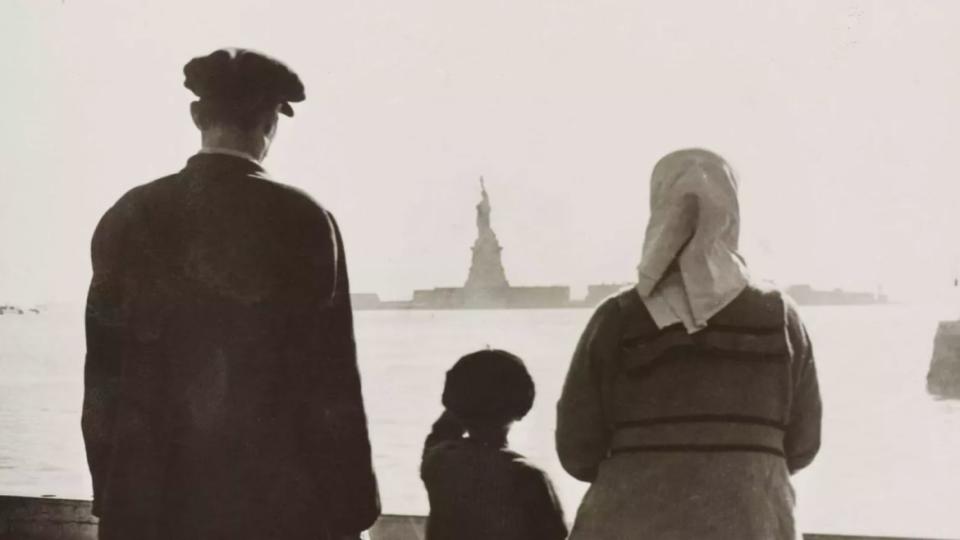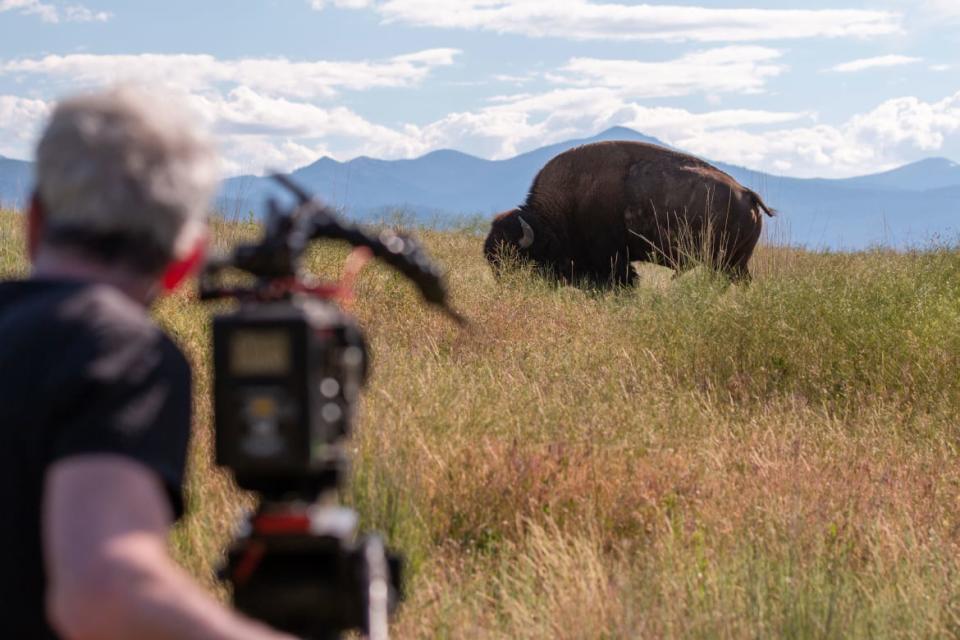Why Ken Burns Will Never Go Hollywood

- Oops!Something went wrong.Please try again later.
Ken Burns is America’s preeminent cine-historian, a filmmaker whose work has told the story of our country from innumerable angles and perspectives. On the heels of last year’s The U.S. and the Holocaust, he returns to PBS on Oct. 16 with The American Buffalo, a two-part, four-hour examination of that most mythic of American beasts and its central role in the nation’s westward expansion. At once a stirring tribute to the once-ubiquitous creature and a lament for its near-eradication at the hands of settlers and businessmen, Burns’ latest is a saga of greed, violence and tragedy.
It's also a parallel tale about America’s treatment of its indigenous population, who for centuries had lived in symbiotic harmony with the buffalo, hunting it for all manner of literal and spiritual sustenance, and receiving in return protection, stability and kinship with the natural world. The American Buffalo is thus a snapshot of pioneers’ avaricious slaughter of the beast not simply for profit but as a means of undermining the very fabric of Native American life (if not annihilating it altogether). That aspect makes The American Buffalo a kindred spirit to The U.S. and the Holocaust, detailing the active and passive parts played by the U.S. in the extermination of others.

Far from simply a scathing censure, though, Burns’ documentary is also, in its second half, a hopeful reminder that not all mistakes are irreversible. The fact that such noble about-faces are often spearheaded by those with ignoble ideas only further speaks to the unruliness of history, which Burns navigates with his typically deft hand. Enchanting, disheartening and cautiously optimistic all at once, it’s another triumph for the director, who spoke with us ahead of The American Buffalo’s premiere—and before the start of the Israel-Hamas war—about genocide, inevitability, and the enlivening messiness of non-fiction storytelling.
This conversation has been edited for length.
On the face of it, The American Buffalo seems like a stark departure from The U.S. and the Holocaust, although it’s not, in the sense it too is about America’s culpability in massacres—in this case, of the Buffalo and the Native Americans.
Why do I have to deal with eugenics two films in a row? [laughs] It’s crazy. But yes, we knew going in that there was nothing cute about doing a biography of an animal. By choosing to center the buffalo, we were also centering not just the myriad tribes and their complex 10,000-year relationship with the buffalo, but also those newcomers who did everything they could to exterminate the buffalo and, by extension—not even a wink-wink—get rid of the Indians.
Was this project born from a continuing interest in that subject, or did it just happen to turn out that The American Buffalo and The U.S. and the Holocaust were related?
It turned out that they were related. We’d been thinking about this for more than 30 years, to do a stand-alone film about the buffalo. A lot of it came out of our mid-’90s film The West, but even before that, we’d been thinking about it. Then we did Lewis & Clark and The National Parks, so we’d always talked about it; we were just looking for the daylight and the bandwidth to be able to do it.
I’m really glad we waited because, first of all, I think we could avail ourselves of new scholarship; several of the scholars, both Native American and other in the film, were able to publish in the last 30 years some really important works that helped clarify the story, not just from a political and cultural and ethnographic point of view, but from a biodiversity point of view. From other positions that helped us frame it and understand it in a different way.

I also think it gave us a chance, perhaps, to mature as filmmakers that would allow us to not just pay lip service to other points of view, however well-intentioned that lip service might be. To not be paternalistic or patronizing in any way, but to actually also center the story of not “them,” the Native Americans, but the diversity of Native Americans who had intricate, extraordinary relationships with the buffalo, and then what happened when we came.
Why Ken Burns Is Exposing America’s Evils During the Holocaust
At the heart of the story is commerce, and the way it drove the buffalo’s extinction, which in turn led to the Native Americans’ further marginalization.
What happened when we came [to the Great Plains] was that market pressures were working against the buffalo. It occurred to people during the course of it, and there’s the terrifying, bone-chilling quote from Theodore Roosevelt that says, basically, it’s bad that the buffalo is going to go extinct, but I guess it’s inevitable and it will help us with the “Indian question” and the advance of white civilization. You realize, as one of the Native Americans says, it's kind of a twofer. You get rid of the buffalo, and you get rid of the Native Americans.
It's interesting too that William T. Hornaday—who, like Theodore Roosevelt, probably subscribed to many of the abhorrent views not just of white supremacy but of eugenics—also understands that if an animal is commodified and valuable for a marketplace, it’s all over, it’s done. Passenger pigeon, gone. Beaver, almost gone. Buffalo, to the very edge of extinction and then it’s brought back. So, there’s a lot of underlying complicated history to try to tell.
Part of that complication is the fact that this story is also hopeful, right?
It’s also the story of the people who do bring it back. This is a parable of the extinction, and those people are not just fixed in one point as convenience would suggest that we try to do. [Theodore Roosevelt] does grow. William T. Hornaday does move from wanting to kill and stuff them to wanting to save them and starts the National Zoo and the Bronx Zoo. So they’re going somewhere, for whatever reasons they’re doing it. And then there are lots of people, like Charlie Goodnight, Buffalo Bill, Buffalo Jones, Michel Pablo, and Fred Dupree and Scotty Philip. Scotty Philip and Dupree are in the Dakotas, and Michel Pablo has the biggest herd in Montana, and they’re saving it because they think it’s the right thing to do.
A whole group of people—which is a classic American thing—comes together, not unlike the dynamics of the national parks, which you think are some fiat from on high. But no, it takes local championing by an individual or a group of associations to fight against relentless local commercial interests, and they prevail or don’t prevail. What happens is we end up, by hook or by crook, saving the buffalo. It is no longer extinct. But now the question is, is it just enough to have it as a zoo or corral animal, or are we willing to go the next step? Maybe our first two episodes are the first two acts of a three-act play and the third act is yet to be written about whether we can create spaces large enough for them to be wild and free again.
The big question I want to ask you has to do with inevitability. More than one person (including your writer Dayton Duncan) says the slaughter of the buffalo was not inevitable. Do you feel the same? And if so, what part of this story was avoidable, and which part wasn’t?
You’re asking a really great question that moves into the counterfactual. It wasn’t inevitable; nothing is inevitable. You can acknowledge that, meaning—without speaking for Dayton or any of the other speakers who address this, or to presume what was in their heads and hearts—that you hope that human nature would be a different sort of thing. That the best of human nature—“the better angels,” as Abraham Lincoln would say—would triumph. But they didn’t. The story is about that. And it’s not unreasonable to bring in “it’s not inevitable,” just as you can bring in the myth of inexhaustibility that Michael Punke does—that with the vastness of the land, people thought, we’re not going to run out of anything! And we ran out of buffaloes and lots of spaces, and the national park impulse is, oh my God, this is going to disappear, let’s save some of the more beautiful places.
What was the most surprising thing you discovered while making The American Buffalo?
To me, the most confounding moment is in part two, when the Indian head nickel comes out, with [a buffalo named] Black Diamond on the back—who gets sent down to the meat-packing district in Manhattan and cut up for steaks and parted out—because we’re now beginning to romanticize, and fetishize even, these two entities that we spent the better part of the last century trying to get rid of. What does that say? If the sculptor [James Earle] Fraser thinks he wants to make a coin that will be unmistakable for any other coin, what has come to symbolize us? The Native American and the buffalo. But we’ve also killed them. It prompts George Horse Capture Jr. to say, you’ve got to explain to me, why do you destroy the things you love? That is the big, big question, and it goes straight to the heart of our own identity.
The ”Indian question” made me think about The U.S. and the Holocaust…
Hitler admired and wrote about this. Hitler admired that we had taken care of the Indians and exterminated or isolated them in reservations, which he would probably have no problem translating to concentration camps.
It was an unofficial but widely accepted idea/policy that exterminating the buffalo would help resolve the “Indian question.” Was that also bolstered by everyday American intolerance of (and indifference toward the plight of) Native Americans?
The willing executioners, yeah. I think it’s true, and it was not an official policy, as you say. But it was an articulated policy, by everybody. I think Dayton makes a good point on camera that the progressives create the Indian schools, and the Indian schools cut off your queue, make you dress in Western garb, and beat you if you speak your language or practice your cultures or rituals. These are the friends of the Indians. And we know from Phil Sheridan and William Tecumseh Sherman what the enemies of the Indians feel like.
De Tocqueville said in the ’30s, our religion is money. We then, in the late ’40s, articulate Manifest Destiny and O’Sullivan’s famous quote about “our manifest destiny is to overspread the continent allotted by Providence for the free development of our yearly multiplying millions,”—meaning it’s our destiny to have this. Then you have Frederick Jackson Turner’s essay in 1893 which says the frontier is closed, and there’s this crisis of confidence and identity that happens among white Americans. It seems that, at that point, there’s a prick of conscience about what we’ve taken over. Jefferson thought it would take 100 generations to fill up what Lewis and Clark had explored. It took three! That gave people pause, and that accelerated the concern for conservation, and national parks, and setting aside lands for the buffalo.
Dan Flores comes right out and says it, and I don’t think we should hide this; this is the largest slaughter of wildlife in the history of the world. It’s not just the buffalo, but it’s principally the buffalo. That’s on our watch! I think Americans woke up.
One of this story’s chief complications is the fact that many of the most ardent buffalo conservationists (Buffalo Bill, Charlie Goodnight, Roosevelt, etc.) began as buffalo hunters. Do you frequently find that reversal in history?
I think we have to accept, especially people who are disconnected from the long arc of our history, and maybe ardent conservationists now, that that movement is born among hunters, who were worried that what happened to the passenger pigeon will happen to fill-in-the-blank, their favorite animal to hunt. They’re beginning to see that there have to be sustainable ways to conduct this sport.
Theodore Roosevelt moves in that direction, and wildlife refuges are a part of it. He doesn’t lose the Manifest Destiny or the white supremacy or the hatred of, as he calls them, “the savages.” Maybe there’s a begrudging connection with Quanah [Parker], one old warrior to another. But you can only hypothesize and over-romanticize that. Other people go some distance, like Hornaday. But at the heart of the saving of the Redwoods is Madison Grant, who wrote The Passing of the Great Race, the eugenics bible.
The late scenes of the buffalo’s reverse-migration from the Bronx Zoo are particularly astounding.
To me, the most gobsmacking scene in the movie is when Roosevelt creates the Wichita Mountains Reserve, which is on Kiowa land and includes Mount Scott, where the Kiowas believe the buffalo came out and into which the buffalo went in this terrible period of the 1870-1880s, when most of the slaughter took place. Where are you going to get your buffalo as your seed stock? You’re going to ship them from a zoo in the largest city in America. At the Fordham train station, they load these buffalo onto the trains to go out to their new old home. I just think, you can’t make this up. People go, “Documentaries, that’s a stepping stone to features, Ken—why haven’t you done that?” I go, because I would submit that, with The U.S. and the Holocaust or the Vietnam film or the Muhammad Ali film, you don’t have to make shit up for it to be beyond belief.
Is that messiness of history, and people, and life, what’s still most attractive to you about non-fiction filmmaking?
Yes! You know, I’ve lived for the last 44 and a half years in New Hampshire. I left New York to finish my first film because I needed to get a real job. And if I got one, I would have forgotten the film and put it up on top of the refrigerator or a bookshelf and woken up at 45 and not completed it. So I moved to this remote town and stayed there. Even though the first film got nominated for an Oscar and everyone said, ‘Oh you’re coming back to New York and moving to LA,’ I said no. I like that labor-intensive stuff.
In my editing room is a neon sign that, in lower-case cursive, says, “It’s complicated.” That’s it. Because there’s not a filmmaker—feature or documentary—that, if the scene is working, you don’t want to touch it. I’ve spent 50 years in the business of opening up scenes that were already working and making them more complicated. Perhaps destabilizing what made them work but making the whole better because you realized you had to do that.
Winton Marsalis said to me, on camera, in Jazz, “Sometimes the thing and the opposite of a thing are true at the same time.” I just went, yes! Thank you! Geoffrey Ward, my principal writer, always talks about give and take away. You’re not doing it deliberately; there’s no rhythm or formula to it. But inevitably, and I know it’s true of me and I would suggest it’s true of you, that we’re a bundle of contradictions.
Is that when a non-fiction film is working best—when it’s not trying to sand a story’s sharp edges?
We lament today the lack of heroes but in fact, the whole idea of heroism was not perfection but in fact a war between a person’s strengths and weaknesses. They were put in the boldfaced names of the times, which were the gods, right? They have bigger lives than the rest of us non-bold-faced people, but there’s Achilles with his hubris and his heel to go along with his great strength, and there’s this guy flying too close to the sun. You get these great moral principles, but they have nothing to do with perfection or what we now call heroism. They have to do with imperfection and the constant human struggle to do that.
There’s no place where that plays out better, or at least unfettered, than in good documentaries. Good storytelling of good non-fiction. Because the tendency in Hollywood is to abbreviate and make superficial—the white hat or the black hat. It’s not to say that Hollywood hasn’t done amazing work that has more complexity than you can imagine; it has and it will continue to do so, just as world cinema does. But I don’t need to leave my day job!
Ken Burns Shows Us How Benjamin Franklin Shaped Our World
Get the Daily Beast's biggest scoops and scandals delivered right to your inbox. Sign up now.
Stay informed and gain unlimited access to the Daily Beast's unmatched reporting. Subscribe now.
